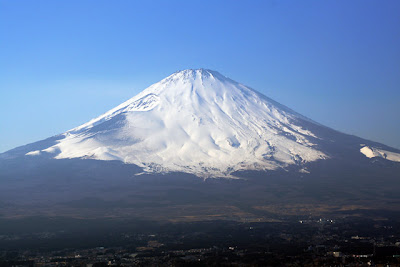 Cross-section of a typical Stratovolcano showing composite,
Cross-section of a typical Stratovolcano showing composite,stratified nature with alternating layers of lava and tephra.
Source: http://pubs.usgs.gov/gip/volc/fig10.gif
Some of the Earth’s grandest mountains are composite volcanoes (aka stratovolcanoes). Stratovolcanoes show alternate layering of lava flows, tephra and volcanic ash, which is why they are called composite volcanoes. They are usually steep-sided, symmetrical cones of large dimension built of alternating layers of viscous andesitic lava flows, volcanic ash, cinders, blocks, and bombs and may rise as much as 8,000 feet above their bases. The high silica content of the magma results in it being viscous. It also makes gases trapped in it harder to escape, which frequently results in explosive eruptions. The steep slope near the summit is partially due to the thick, short viscous lava flows that are unable to travel far down the slope. The gentler base is due to the accumulation of material from the volcano and also pyroclastic material.
Most of the composite volcanoes have a crater at the summit which is formed by the explosive ejection of material from the central vent. Sometimes the craters have been filled in by lava flows or domes, or with glacial ice and less commonly they are filled with water.

 The sequence of events for a violent eruption of Mount St. Helens, a composite volcano, in 1980. In the first photograph taken at 8:32:47, the original cone is intact, with some steam rising from the vent. The last photograph taken at 8:33:18,
The sequence of events for a violent eruption of Mount St. Helens, a composite volcano, in 1980. In the first photograph taken at 8:32:47, the original cone is intact, with some steam rising from the vent. The last photograph taken at 8:33:18,shows the original cone blowing up.
Source: http://erg.usgs.gov/isb/pubs/teachers-packets/volcanoes/poster/graphics/posterfig6-7.jpg
Some of the most beautiful mountains in the world are composite volcanoes, including Mount Fuji in Japan (shown in the picture below), Mount Mayon in the Phillipines, Mount Cotopaxi in Ecuador , Mount Shasta in California, Mount Hood in Oregon and Mount Rainier in Washington.

No comments:
Post a Comment